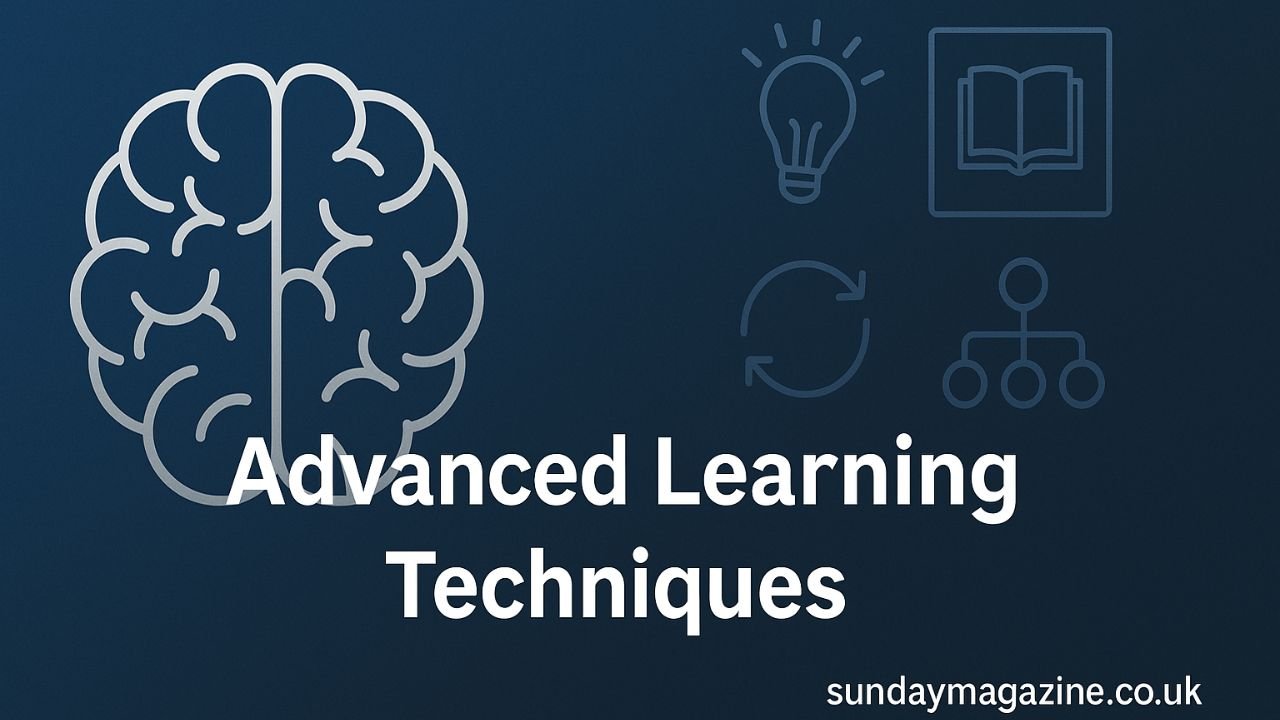Discover advanced learning techniques to boost retention, improve focus, and master new skills efficiently. Explore methods like spaced repetition, active recall, and mind mapping to enhance your learning process.
In the fast-paced world we live in, the ability to learn efficiently and retain information is crucial to personal growth, academic success, and career advancement. With so much content available online and in various formats, how do you ensure that the knowledge you absorb sticks and helps you advance? The answer lies in adopting advanced learning techniques that cater to your brain’s natural processes and enhance your cognitive abilities.
In this article, we’ll dive deep into advanced learning techniques, exploring proven methods, cognitive science behind learning, and practical steps you can implement today. Whether you’re a student trying to ace exams, a professional upgrading your skills, or simply someone passionate about learning, these techniques will transform the way you study, work, and grow.
ALSO READ: Super Clever Advanced Learning Method
What Are Advanced Learning Techniques?
Advanced learning techniques go beyond traditional memorization and passive reading. These methods focus on understanding how the brain processes and retains information, allowing learners to absorb, comprehend, and recall knowledge more effectively. Some of these techniques are rooted in cognitive science, while others stem from insights gained through years of research on how humans learn best.
From spaced repetition to active recall, and from mind mapping to retrieval practice, these methods provide an edge over traditional rote learning, improving both speed and quality of learning.
Why Are Advanced Learning Techniques Important?
In an age where information is readily available but the ability to retain it is scarce, mastering advanced learning techniques is essential. Here are some of the key reasons why these techniques are important:
- Improved Retention: Retaining knowledge long-term is challenging, but techniques like spaced repetition and active recall make it easier to remember what you’ve learned.
- Time Efficiency: Advanced learning methods help you study smarter, not harder, maximizing your results in less time.
- Critical Thinking: These techniques emphasize understanding and application rather than memorization, which promotes deep thinking and problem-solving skills.
- Adaptability: As the workplace evolves and new fields emerge, these learning methods enable you to quickly acquire new skills and adapt to changing demands.
1. Spaced Repetition: A Revolutionary Approach to Retention
Spaced repetition is one of the most powerful advanced learning techniques. This technique involves reviewing information at increasing intervals, which allows your brain to better store and recall the information over time. The principle behind spaced repetition is based on the forgetting curve, which suggests that we forget information rapidly after initially learning it unless we review it periodically.
How Spaced Repetition Works
Spaced repetition works by reinforcing memories at strategically spaced intervals, helping to strengthen neural connections. Here’s how to use it effectively:
- Start by Learning New Material: Begin by reviewing the material for the first time.
- Space Out Your Reviews: After the first review, increase the intervals between reviews. For example, review after 1 day, 3 days, 7 days, and then 14 days.
- Use Spaced Repetition Software: Tools like Anki or SuperMemo automate this process by adjusting the review intervals based on your recall performance.
Benefits of Spaced Repetition
- Long-Term Retention: Helps move information from short-term to long-term memory.
- Time Efficiency: By focusing reviews on the material you’re struggling with, spaced repetition optimizes your learning time.
2. Active Recall: Mastering the Art of Retrieval
Active recall is the process of actively retrieving information from memory, rather than passively reading or highlighting. It’s one of the most effective techniques for strengthening memory and enhancing learning.
How Active Recall Works
Active recall forces your brain to work harder in retrieving information, which helps reinforce neural pathways. Here’s how to practice it:
- Study Material: Begin by studying the material in a passive manner, such as reading or watching videos.
- Test Yourself: After studying, test yourself on the material by recalling the key points without looking at your notes.
- Use Flashcards: Flashcards are an excellent tool for active recall. Write a question on one side and the answer on the other. Review and try to answer the question from memory.
Benefits of Active Recall
- Improved Memory: By actively engaging with the material, you’re more likely to remember it.
- Deeper Understanding: Active recall forces you to process information deeply, improving your overall comprehension.
3. Retrieval Practice: Strengthening the Brain’s Recall Abilities
Retrieval practice is similar to active recall but emphasizes repeated retrieval attempts, even when you don’t have access to the original material. This technique involves repeatedly testing yourself on the material over time.
How Retrieval Practice Works
Retrieval practice can be done in various ways:
- Practice Tests: Use quizzes and practice exams to reinforce what you’ve learned.
- Self-Quizzing: Ask yourself questions about the material and attempt to answer them from memory, even without flashcards or notes.
- Write Summaries: After studying, write a summary of what you’ve learned without referencing your notes. This helps strengthen recall and understanding.
Benefits of Retrieval Practice
- Strengthens Neural Pathways: Repeatedly retrieving information builds stronger neural connections, making it easier to recall the material in the future.
- Prepares for Real-World Application: Retrieval practice simulates real-world scenarios where you must recall knowledge without direct access to resources.
4. Mind Mapping: Visualizing Concepts for Better Understanding
Mind mapping is an advanced learning technique that helps organize information visually, making it easier to understand and recall. By creating a visual representation of ideas and their relationships, you can better grasp complex concepts and organize your thoughts.
How Mind Mapping Works
Mind mapping involves creating a central node (usually a concept or topic) and branching out with related ideas, facts, and subtopics. The structure looks like a tree, with branches extending outward.
Steps to create a mind map:
- Start with a Central Idea: Write the main topic or concept in the center.
- Add Branches for Key Points: Draw lines from the central node and add key points, facts, or subtopics.
- Expand on Each Branch: Continue adding details to each branch, making the map more intricate as needed.
Benefits of Mind Mapping
- Enhanced Understanding: Helps visualize connections between ideas and concepts.
- Improved Retention: Visual aids stimulate both the left and right brain, enhancing memory retention.
- Creative Thinking: Encourages brainstorming and thinking outside the box, which can lead to innovative ideas.
5. The Feynman Technique: Teaching to Learn
Named after physicist Richard Feynman, the Feynman Technique is a powerful method for mastering complex concepts. The technique involves explaining a topic in simple terms, as though you’re teaching it to someone else.
How the Feynman Technique Works
- Study the Topic: Begin by thoroughly studying the concept or material.
- Explain it Simply: Try to explain the concept in simple language, as though you’re teaching a child or a beginner.
- Identify Gaps: While explaining, identify any gaps in your knowledge or areas where you struggle. Go back to your notes or research to fill in those gaps.
- Repeat the Process: Refine your explanation and simplify further as needed.
Benefits of the Feynman Technique
- Deepens Understanding: Explaining a topic forces you to understand it at a deeper level.
- Reveals Knowledge Gaps: Helps you identify and address areas where your understanding is weak.
- Boosts Confidence: Teaching material to others reinforces your own confidence in the subject matter.
6. The Pomodoro Technique: Maximizing Focus and Productivity
The Pomodoro Technique is a time-management method that helps boost focus, productivity, and learning efficiency. It involves working in short, focused intervals, followed by a short break. This helps prevent burnout and maintains mental sharpness throughout study sessions.
How the Pomodoro Technique Works
- Set a Timer: Choose a task to work on and set a timer for 25 minutes.
- Work Intensely: During the 25-minute interval, focus entirely on the task at hand.
- Take a Break: After the 25 minutes, take a 5-minute break to relax and recharge.
- Repeat: After completing four cycles, take a longer break of 15-30 minutes.
Benefits of the Pomodoro Technique
- Increased Focus: Short work intervals help maintain focus and avoid distractions.
- Reduced Mental Fatigue: Regular breaks prevent burnout and keep your mind fresh.
- Enhanced Productivity: The technique encourages sustained work over longer periods without sacrificing quality.
7. Interleaved Practice: Mixing Topics for Better Retention
Interleaved practice is a technique where you mix different topics or skills during a single study session, rather than focusing on one topic at a time. This technique enhances your ability to apply knowledge across different contexts and situations.
How Interleaved Practice Works
Instead of studying one subject or concept intensively, you alternate between different topics or skills within the same session. For example, when studying math, you might switch between algebra, calculus, and geometry problems, rather than working on one type of problem exclusively.
Benefits of Interleaved Practice
- Improved Learning Flexibility: Helps apply knowledge in a variety of contexts.
- Better Retention: Mixing topics challenges the brain and helps it retain information better than block learning.
- Enhanced Problem-Solving Skills: Encourages you to adapt knowledge to different situations.
Conclusion: Embracing Advanced Learning Techniques for Lifelong Success
Mastering advanced learning techniques is key to maximizing your learning potential. By implementing strategies like spaced repetition, active recall, and mind mapping, you can enhance your memory retention, improve focus, and develop a deeper understanding of complex subjects.
These techniques don’t just apply to students—they can be used by anyone, from professionals to lifelong learners, to boost cognitive abilities and adapt to the ever-changing demands of the modern world.
FAQs on Advanced Learning Techniques
1. What are advanced learning techniques?
Advanced learning techniques are strategies designed to enhance learning efficiency and memory retention. These include methods like spaced repetition, active recall, mind mapping, and retrieval practice, which focus on deeper understanding and long-term retention.
2. How does spaced repetition improve learning?
Spaced repetition helps reinforce memory by reviewing information at increasing intervals, preventing forgetting and moving knowledge from short-term to long-term memory.
3. What is active recall, and why is it effective?
Active recall involves testing yourself on the material instead of passively reviewing it. This strengthens neural connections and improves memory retention.
4. How does the Feynman Technique work?
The Feynman Technique involves teaching a concept in simple terms to ensure you truly understand it. It helps identify knowledge gaps and reinforces learning through explanation.
5. What is mind mapping, and how can it help?
Mind mapping is a visual tool that organizes information, showing the relationships between concepts. It helps improve understanding, memory, and creative thinking by linking related ideas.
6. Can the Pomodoro Technique improve learning efficiency?
Yes, the Pomodoro Technique boosts focus and productivity by working in short, timed intervals followed by breaks, preventing burnout and maintaining mental sharpness.
7. What is interleaved practice, and how does it benefit learning?
Interleaved practice involves switching between different topics or skills during study sessions. This technique improves retention, adaptability, and problem-solving abilities by challenging the brain to apply knowledge in diverse contexts.
8. How can I apply these techniques to my daily study routine?
Incorporate one or more of these techniques into your study schedule. For example, use spaced repetition for review, active recall for self-testing, and mind mapping to organize complex concepts.





